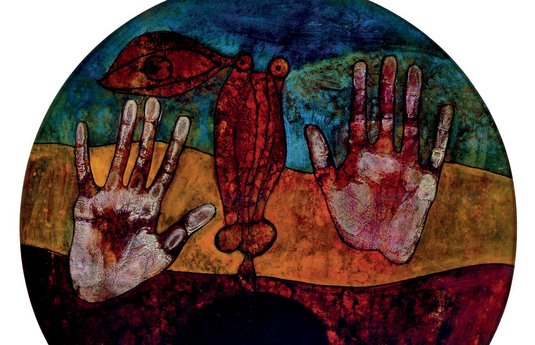Exhibition / Museum
Farid Belkahia
19 May - 19 Jul 2021

The event is over

Farid Belkahia, « Hommage à Gaston Bachelard », 1984. Centre Pompidou, Paris. © Adagp, Paris 2021
The exhibition dedicated to Farid Belkahia (1934, Marrakesh - 2014, Marrakesh) - today considered as one of the founders of Moroccan and, more generally, Arabic artistic modernity – articulates around two consecutive periods in his work: the artist’s Prague and expressionist period beginning in 1959, and his return to Casablanca in 1962, with a room specially dedicated to his copper works. The visit ends with a series of works made using goat’s hide, establishing a dialogue between the avant-garde and traditional culture.

Farid Belkahia, « Hommage à Gaston Bachelard », 1984. Centre Pompidou, Paris. © Adagp, Paris 2021
It was his works on animal hide that would earn Farid Belkahia the key place he now holds in the history of art in recent decades. The exhibition also places particular importance on his works on paper, a daily practise in which the work is projected toward every possibility and is given over to the pure pleasure of creation. The Centre Pompidou thus continues its participation in the ongoing task of writing the history of non-Western modernities.
In 1959, Farid Belkahia already knew he would not be a Moroccan painter of the Second School of Paris. He therefore decided to leave France, where he was studying, and travel to Prague to study scenography. There, his own form of expressionism would cast off what remained of Occidental pictorial tradition. It was in Prague that his first masterpieces were created.
The second period of the exhibition began in 1962, when Farid Belkahia returned to Morocco and became director of the Casablanca School of Fine Arts. With the help of certain key figures, he would radically transform the teaching there in an effort to reconnect the artistic modernity with vernacular traditions and ancestral crafts, condescendingly dismissed as insignificant folk practices by the colonial view. It was during this period that a movement was born: the Casablanca School, of which Farid Belkahia was a key member and which is now held up as one of the cardinal manifestations of post-colonial modernity.
In 1963, a year after his appointment at the head of the School of Fine Arts, Farid Belkahia gave his work a determining new direction, with the adoption of copper. The decision led to a rupture with Western painting: “I deliberately chose a material with strong roots in the Moroccan craft tradition". In 1975, after departing as head of the School, Farid Belkahia further anchored his work in craft tradition by replacing copper with goat’s hide.
Generous contributions and loans from the Mathaf in Doha and the Farid Belkahia Foundation in Marrakesh allow visitors to discover a large collection of works, casting a spotlight on one of the historical founders of Arab modernity.
Exposition réalisée en partenariat avec le Mathaf : Arab Museum of Modern Art, Doha et avec la collaboration de la fondation Farid Belkahia, Marrakech
When
11am - 9pm, every days except tuesdays
Online reservation required


